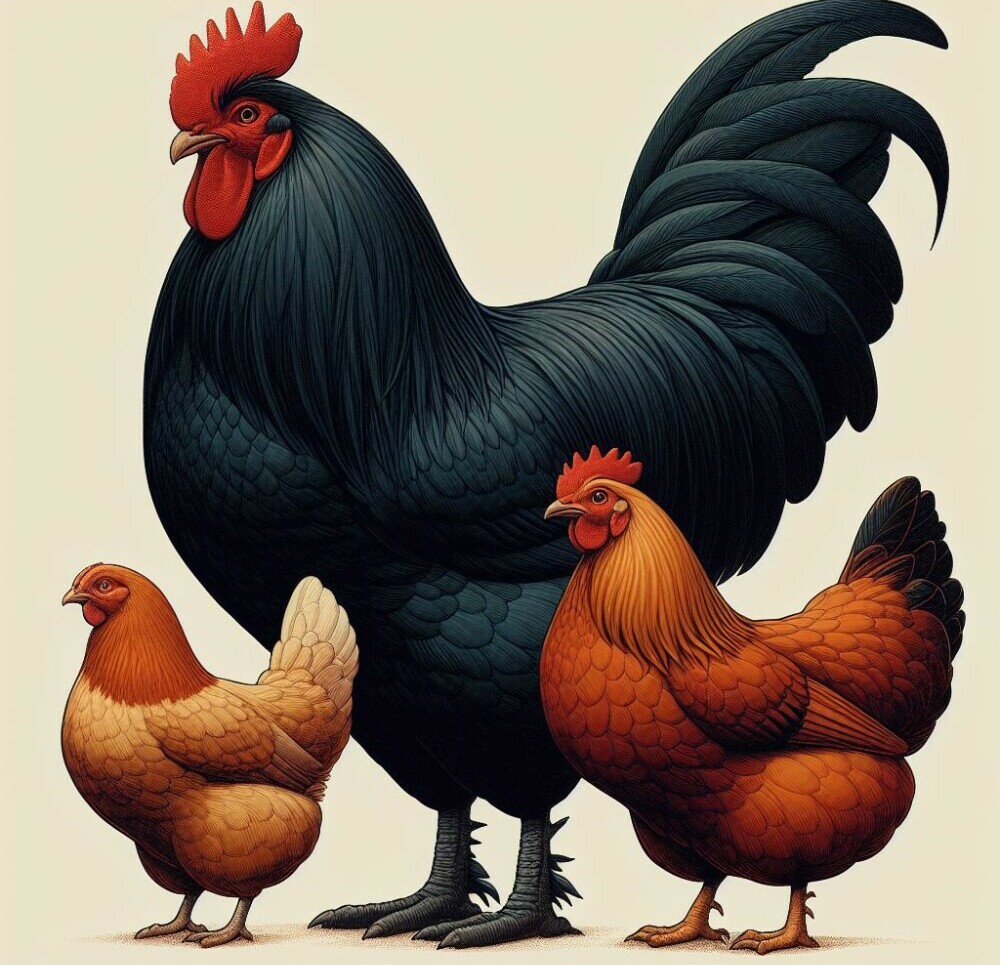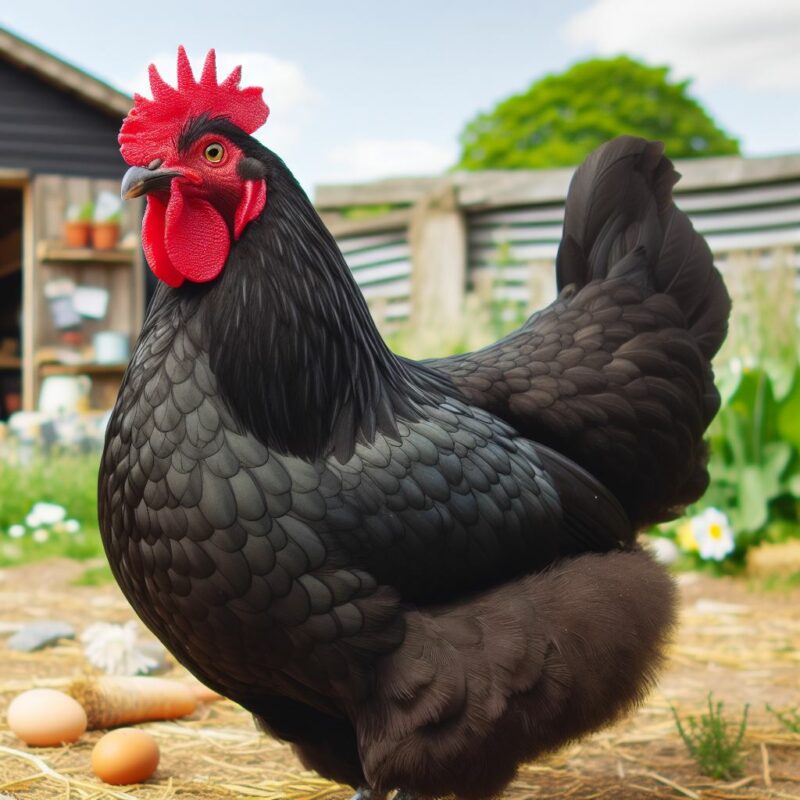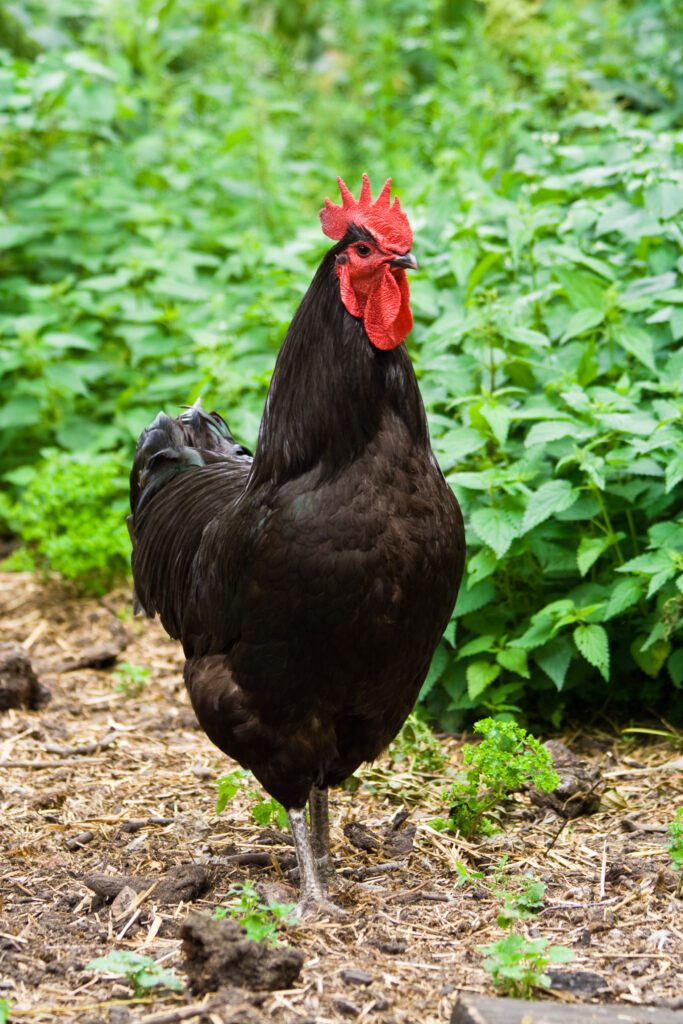
When it comes to noticeably different chickens, the Jersey Giant stands out as a true behemoth, a feathered giant that commands attention with its impressive stature.
But behind this majestic presence lies a fascinating origin story, a tale of dedicated breeders and a desire for a chicken that surpassed all expectations.
You’ll agree that the breeders got more than they bargained for with this giant beauty.
The History and Original Breeders of the Jersey Giant Chicken
The Jersey Giant’s journey began in the late 19th century in the heart of Burlington County, New Jersey. It was here that two brothers, John and Thomas Black, embarked on a mission to create a chicken breed of exceptional size and productivity.
Inspired by the Black Langshan, a large Chinese breed, the Blacks began selectively breeding their chickens to enhance their size and egg-laying capabilities.
The driving force behind the development of the Jersey Giant was the desire for a chicken that could provide both meat and eggs in abundance.
At the time, the poultry industry was booming, and there was a high demand for chickens that could produce a plentiful supply of both.
The Blacks believed that a larger chicken would yield more meat and eggs, meeting the market’s growing needs.
What Effect Did the Influence of the Breed’s Origin Have on Its Size and Characteristics
The Jersey Giant’s origins in New Jersey, a state known for its fertile soil and abundant agricultural resources, undoubtedly played a role in its development.
The access to nutritious feed and the temperate climate likely contributed to the breed’s impressive size and growth rate.
Additionally, the Blacks’ selective breeding practices, focused on enhancing size and productivity, further solidified the Jersey Giant’s unique characteristics.
The Size Superiority: Comparing the Jersey Giant with Other Chicken Breeds
The Jersey Giant stands tall among its chicken counterparts, with roosters reaching heights of up to 26 inches and weighing in at a staggering 15 pounds. Hens, though slightly smaller, still command attention with their 20-inch frames and 10-pound weight.
Does size matter? Sometimes. Check out the video below to see what a hawk thinks of the Jersey Giant.
PhotosOff-stage Curtain Reveal: Showcasing Comparative Sizes with Other Chicken Breeds
To truly appreciate the Jersey Giant’s size dominance, let’s compare it to other popular chicken breeds. The Rhode Island Red, a well-known dual-purpose breed, averages 20 inches for roosters and 14 inches for hens.
The Brahma, another large breed, reaches 24 inches for roosters and 19 inches for hens. Even the towering Cochin, known for its fluffy plumage, falls short of the Jersey Giant’s impressive height and weight.
Possible Factors Contributing to the Size of the Jersey Giant
Several factors likely contributed to the Jersey Giant’s exceptional size.
The breed’s genetic lineage, with its roots in the large Black Langshan, undoubtedly played a significant role. Additionally, the Blacks’ selective breeding practices, focused on size maximization, further enhanced the breed’s stature.
The Jersey Giant’s access to nutritious feed and favorable environmental conditions in New Jersey also likely contributed to its growth potential.
Most people probably don’t realize how fertile some parts of New Jersey are. If you ever get a chance to drive through Jersey’s onion fields, take it. You’ll be impressed.
The Secret Behind the Size: How Did The Jersey Giant Get So Big?

While the exact mechanisms behind the Jersey Giant’s large size remain somewhat elusive, scientists have identified several contributing factors.
The Jersey Giant’s genetic makeup plays a crucial role in its size determination. Genes control the expression of traits, and the Jersey Giant’s genes dictate its skeletal structure, muscle mass, and overall growth potential.
Researchers have identified specific genes associated with size in chickens, and the Jersey Giant’s unique genetic profile likely includes these size-influencing genes.
Does Nutrition Play a Role?
Nutrition is another key factor in determining the size and growth of any living organism, and the Jersey Giant is no exception.
A balanced diet rich in protein, carbohydrates, vitamins, and minerals is essential for proper growth and development.
The Jersey Giant’s typical diet consists of commercial chicken feed, supplemented with grains, vegetables, and fruits. This nutritious intake provides the necessary building blocks for the breed’s impressive size.
I’m really stepping out into conjecture here, but I have to assume that anyone getting one or a few of these massive birds is going to take extra great care of them in order to humbly show them off to friends.
Do Jersey Giants Require Special Care to Keep Them?
While the Jersey Giant’s size is primarily attributed to genetics and nutrition, certain rearing practices can also influence its growth.
Providing ample space for exercise and free-range access allows Jersey Giants to move freely, promoting muscle development and overall well-being.
Additionally, ensuring adequate ventilation in the coop and protection from extreme weather conditions contributes to the breed’s health and growth.
A Closer Look at the Egg-Laying Capacity of the Jersey Giant
Despite their impressive size, Jersey Giant hens are considered moderate egg layers, producing an average of 150-200 extra-large brown eggs annually compared to other heritage chicken breeds.
This egg-laying capacity falls below that of hybrid production breeds, which can produce up to 300 eggs annually.
However, compared to other heritage chicken breeds, Jersey Giants are considered relatively prolific layers compared to other heritage chicken breeds.
Egg Laying Patterns and Frequency: Jersey Giant vs. Other Chicken Breeds
Jersey Giants typically reach sexual maturity and begin laying eggs around 6-7 months. This is average. They lay consistently throughout the year, with a slight decline in egg production during the winter months.
Compared to hybrid breeds, Jersey Giants have a more extended laying season, continuing to lay eggs for several years.
Inspecting the Egg Size and Color Specific to the Jersey Giant Breed
True to their name, Jersey Giants produce large, brown eggs. These eggs are typically classified as extra-large, with a rich, dark brown shell.
The average Jersey Giant egg weighs around 60-70 grams, significantly larger than the standard chicken egg, which averages around 50-60 grams.
| Egg Size | Egg Weight (grams) | Chicken Breeds |
|---|---|---|
| Small | 40-45g | Bantam Plymouth Rock, Belgian d’Uccle |
| Medium | 45-50g | Rhode Island Red, Orpington |
| Large | 50-60g | Sussex, Wyandotte |
| Extra-Large | 60-70g | Jersey Giant, Barred Plymouth Rock |
The Jersey Giant’s large size does have some impact on its egg-laying capacity. While their overall egg production is considered moderate, their individual egg size is significantly larger.
This suggests that the breed’s energy expenditure is directed towards producing larger eggs rather than laying a higher number of smaller eggs.
The Jersey Giant’s Unique Meat Characteristics and Special Needs
Jersey Giants are renowned for their meat quality. Their flesh is known for its tenderness, flavor, and juicy texture. The breed’s slower growth rate allows for its superior taste and texture.
Jersey Giant meat is often described as having a mild, slightly sweet flavor with a hint of gaminess. The breed’s meat is also known for its tenderness and juiciness, making it a popular choice for roasts, stews, and other hearty dishes.
Special Care Needs and Challenges of Rearing Jersey Giants

Due to their large size, Jersey Giants require more space and feed than smaller chicken breeds. Their feed does not need to be different from your other chickens; they just need more of it.
They also need a sturdy coop and run to accommodate their size and weight.
Jersey Giant chickens are generally considered to be a hardy breed. They are known for their robust and resilient nature. Here are some characteristics that contribute to their hardiness:
- Cold Tolerance: Jersey Giants are known for their ability to withstand cold temperatures well. Their large size and heavy feathering help to insulate them against chilly weather.
- Heat Tolerance: While they are better suited for colder climates, they can also tolerate moderate heat with proper care and access to shade and water.
- Disease Resistance: Jersey Giants tend to have good immune systems and are less susceptible to common poultry diseases when compared to some other breeds.
- Docile Temperament: Their calm and docile temperament makes them easier to manage, which can be advantageous for their overall health and well-being.
- Adaptability: Jersey Giants can adapt to a variety of living conditions, including both free-range and confinement settings, as long as they have lots of room. I am biased, however. All of my girls and two boys have the run of my Lone Raven Farm.
While Jersey Giants are not as commercially viable as hybrid production breeds for meat production, they can still be a profitable venture for small-scale farmers or those seeking a superior meat bird. Their large size and high-quality meat can command premium prices in the market.
That’s all for Now
Jersey Giants are a unique and fascinating chicken breed with a rich history and impressive characteristics. Their large size, prolific egg production, and superior meat quality make them a versatile addition to any homestead. Whether you’re looking for a dual-purpose breed for eggs and meat or simply want to raise these gentle giants for their unique presence, Jersey Giants are sure to captivate your and others’ attention.
There are several hatcheries where you can look for Jersey Giant chickens, including My Pet Chicken and Cackle Hatchery, among many.
Thank you for reading. Please leave a comment if you want to share your experiences about Jersey Giants or for any reason.
Dave
Chickenmethod.com
